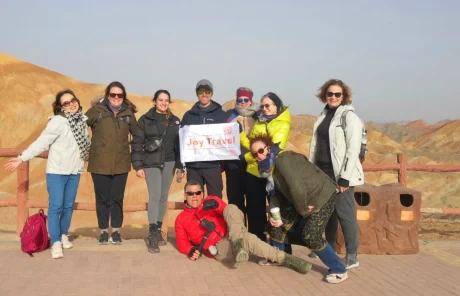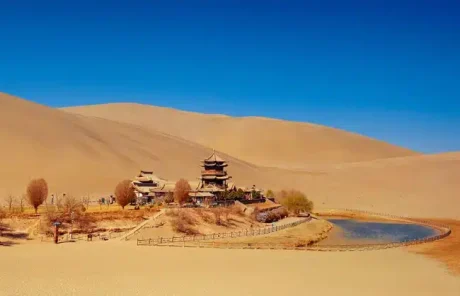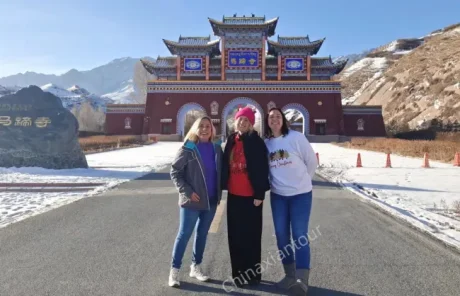Silk Road Travel Guide: Plan an Ultimate Trip along the Silk Route
Used to be a prominent trade route facilitating commercial and cultural exchanges, the Silk Road in China has witnessed the emergence and decrease of civilizations. Starting from Chang’an (today’s Xi’an), this route stretches over 7,000 kilometers and extends to Central Asia and Europe.
If you’re planning a Silk Road travel in China, simply refer to this travel guide for a better travel experience.

Chinese: 丝绸之路 sī chóu zhī lù
The Starting Point of the Silk Road: Chang’an (now Xi’an)
Basic Facts about the Ancient Silk Road
Generally referred to as the mainland Silk Road, this route is the world’s longest cross-land trade route stretching between East Asia and the Mediterranean region as well as parts of North Africa. It went across countries including Kazakhstan, Kyrgyzstan, Uzbekistan, Tajikistan, Afghanistan, Iran, Iraq, Syria, Lebanon, Israel, Turkey, Greece, and Italy.
It was first named the “Silk Road” by the German traveler Ferdinand in 1877 when the luxurious good silk was traded along this route. Nowadays, though it’s not a trade route like before, an increasing number of tourists tend to trace the footprints of the ancient traders and travelers to explore this legendary route.
Read more about 8 Fascinating Silk Road Facts You Didn’t Know.
Why Visit the China Silk Road?
- Discover historic sites. As the Silk Road has witnessed the rise and fall of various civilizations for its rich history, going on a tour along this route allows you to see time-honored cities, historic sites, and ancient temples.
- Marvel atnatural wonders. There are many beautiful attractions along the Silk Road, including the marvelous Danxia Rainbow Mountain, Crescent Spring and Echo Sand Mountain, and Chaka Salt Lake.
- Experience cultural diversity. The Silk Road houses diversified ethnic groups, such as the Hui, the Uyghur, the Tibetans, the Mongols, and more. Visiting there allows you to experience the folk customs in different regions along the
- Sample delicious food. China’s Silk Road spans multiple provinces, and it treats tourists to a wide range of flavorful foods. Never miss Xi’an Biangbiang Noodles, Xinjiang Lamb Skewers, Gansu Niangpi, and other traditional Chinese food on this route.
- Visit remarkable landmarks. The landmarks along the Silk Road attract tourists a lot, such as the Mogao Caves, the Terracotta Warriors, and the Jiayuguan Pass of the Great Wall of China. Through these sites, you’ll get to learn more about the route.
- Embark on a journey by scenic train.A luxurious train named Orient Silk Road Express is available for you to embark on a Silk Road tour and enjoy the scenery along the route. Other than this, the Qinghai-Tibet Railway and the Lanzhou-Xinjiang High-Speed Railway are two railroads to admire the beautiful scenery.
Read more about the Top 6 Reasons to Visit the Silk Road
Route Options of the Silk Road
The Silk Road is never a single road but a network that includes several routes, and so are the tourist routes.
More specifically, the Northern Route starts from Xi’an and it passes through Lanzhou and Dunhuang.
The Southern Route includes cities like Chengdu, Lijiang, and Kashgar.
While the Middle Route traverses Turpan, Urumqi, and Jiayuguan.
Choose the ideal route right for you.

The History of The Silk Road in China
During the reign of Emperor Wu in 138 BC, Ambassador Zhang Qian led a group of people going westward to the Hexi Corridor and built a link between the Central Plains and Western Regions, which marked the beginning of the China Silk Road history.
The Tang Dynasty saw the prosperity of the Silk Road. During this period, China built connections with numerous countries and states in Western Regions, and major cities like Dunhuang and Yumen became commercial and cultural trade centers along the route.
Why was the Silk Road so hugely important? Acted as a bridge of cultural and commercial exchanges in the past, it had a great impact. Many Chinese commodities such as tea, porcelains, silk, and crops were traded to the world, while spice and others were imported to the country, which contributed a lot to the economic development of China and finally made China a great power in the world at the time.
Read more about The History of the Silk Road in China
What to See along China Silk Road
The Silk Road mainly crosses over four provinces in China, including Shaanxi, Gansu, Qinghai, and Xinjiang. They present a wide range of historic sites and natural wonders to explore.
Shaanxi: Terracotta Statues, Ancient Architecture, Delicacies
As the starting point of the Silk Road, Xi’an in Shaanxi surprises visitors with thousands of vivid life-sized Terracotta Warriors and Houses, which are recognized as the eighth wonder in the world. The city also greets tourists with ancient walls and time-honored buildings with old styles of architecture, being a symbol of its heritage and its history. Besides, Shaanxi is famous for its delicacies, never miss the hot oil noodles, Roujiamo (a Chinese hamburger), and Yangrou Paomo.
Gansu: Ancient Fortress, Danxia Landforms, Grottoes, Deserts
Gansu is also an important province along the Silk Road that boasts a great variety of landscapes. There, you can find the Jiayuguan Pass of the Great Wall, which has a strategic location in ancient China’s defense. Next to it, a vast Gobi desert and rolling hills of the Qilian Mountains are within sight.
Also, for its unique location and climate, Zhangye in Gansu houses colorful and magnificent rock formations of Danxia landforms and is listed as one of the “Top 10 Geographical Wonders of the World.” The Mogao Grottoes in Dunhuang and Maiji Mountain Grottoes in Tianshui are also well-known destinations on the Silk Road.
Xinjiang: Juicy fruits, Uyghur Traditions, Grand Bazaar, Mountains
Covering a vast area in China, Xinjiang is famous for its juicy fruits such as grapes and Hami melons. With the dominant ethnic group being the Uyghur, Xinjiang has kept the traditions of the past on the Silk Road, which can be traced through people‘s gatherings, customs, cuisine, and the lifestyle of Kashgar Old Town.
The Xinjiang markets on the Silk Road have turned into Grand Bazaar, where people can marvel at the unique architecture, taste delicious food, take interesting pictures, and get handicrafts as souvenirs. Except for the folk culture, Xinjiang also attracts visitors with its natural beauty of Heavenly Lake of Tianshan Mountains, grasslands, and deserts.
Weather and the Best Time to Visit
Since the route crosses many regions in northwestern China and far from the sea, the weather varies greatly depending on the region and season. Specifically, most cities along the Silk Road experience temperate continental temperatures, which are dry throughout the year with harsh winter and frequent sandstorms in early spring. Therefore, the best time to visit the Silk Road attractions is during the months from May to October when the weather is mild and comfortable for outdoor activities.
Besides, consider visiting there during local festivals and events to experience the culture and customs of the Silk Road in person. For instance, the Silk Road International Tourism Festival in Dunhuang held in September features cultural performances and activities, Turpan Grapes Festival held in August celebrates the harvest of grapes. Gathering and celebrating with the locals brings a good memory on your China Silk Road tour.

Transportation along the Silk Road
The caravan of camels was the main transportation along the ancient Silk Road. But nowadays, things change. The cities on this route can be reached by train, and some major cities like Lanzhou, Dunhuang, and Urumqi offer air services. For a Silk Road tour of more than ten days, combine different modes of transportation to save your time and improve your travel experience.
Useful Travel Tips for a China Silk Road Tour
- Embark on your Silk Road tourfrom Xi’an, since it was the starting point for the ancient Silk Road Route. Also, it offers convenient transportation for visitors to reach other destinations along the route.
- If you want to save time and avoid long transportation, choose a hotel near attractions. Besides, pick a place with local features for a deeper connection to local culture.
- Get to plan ahead. Learn about the local weather in advance, prepare suitable clothing, and carry essential medications.
- Silk Roadis also a route for delicacies. Local restaurants, street food stalls, and night markets are all great places for you to try authentic foods, never miss them.
Read more on China Silk Road Travel Tips 2024

Our Top Recommended Silk Road Tours
- 8 Days Silk Road Adventure Tour from Xining to Dunhuang
- 10 Days Ancient China Silk Road Tour from Xian to Kashgar
- 15 Days In-depth Silk Road Tour from Xian to Xinjiang









